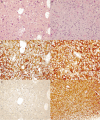Dysembryoplastic neuroepithelial tumors share with pleomorphic xanthoastrocytomas and gangliogliomas BRAF(V600E) mutation and expression
- PMID: 23442159
- PMCID: PMC8029244
- DOI: 10.1111/bpa.12048
Dysembryoplastic neuroepithelial tumors share with pleomorphic xanthoastrocytomas and gangliogliomas BRAF(V600E) mutation and expression
Abstract
Pediatric cortical glioneuronal benign tumors mainly include gangliogliomas (GG) [differential diagnoses pilocytic astrocytomas (PA) and pleomorphic xanthoastrocytomas (PXA)] and dysembryoplastic neuroepithelial tumor (DNT). DNT include the specific form and the controversial non-specific form that lack the specific glioneuronal element. Our aims were to search for BRAF(V600E) mutation and CD34 expression in DNT, PXA, GG and PA to correlate BRAF(V600E) mutation with BRAF(V600E) expression and to evaluate their diagnostic and prognostic values. Ninety-six children were included. BRAF(V600E) mutation was studied by sequencing and immunohistochemistry; CD34 expression was analyzed by immunohistochemistry. BRAF(V600E) mutation was detected in PXA (60%), GG (38.7%), DNT (30%, including 3/11 specific and 3/9 non-specific forms) and PA (12.5%). BRAF(V600E) expression was recorded in PXA (60%), GG (45.2%) and DNT (30%). CD34 expression was recorded in PXA (60%), GG (58.1%), DNT (25%) and PA (12.5%). Neither CD34 expression nor BRAF(V600E) status was predictive of prognosis, except for PA tumors where CD34 expression was associated with a shorter overall survival. In conclusion, DNT shared with PXA and GG, BRAF(V600E) mutation and/or CD34 expression, which represent molecular markers for these tumors, and we recommend searching for CD34 expression and BRAF(V600E) mutation in all DNT, especially the non-specific forms.
Keywords: BRAFV600E expression; BRAFV600E mutation; CD34; dysembryoplastic neuroepithelial tumors (DNT); gangliogliomas (GG); pleomorphic xanthoastrocytomas (PXA).
© 2013 International Society of Neuropathology.
Conflict of interest statement
The authors declare that they have no conflict of interest.
Figures




References
-
- Balss J, Meyer J, Mueller W, Korshunov A, von Hartmann C, Deimling A (2008) Analysis of the IDH1 codon 132 mutation in brain tumors. Acta Neuropathol 116:597–602. - PubMed
-
- Blumcke I, Giencke K, Wardelmann E, Beyenburg S, Kral T, Sarioglu N et al (1999) The CD34 epitope is expressed in neoplastic and malformative lesions associated with chronic, focal epilepsies. Acta Neuropathol 97:481–490. - PubMed
-
- Bodi I, Selway R, Bannister P, Doey L, Mullatti N, Elwes R, Honavar M (2012) Diffuse form of dysembryoplastic neuroepithelial tumour: the histological and immunohistochemical features of a distinct entity showing transition to dysembryoplastic neuroepithelial tumour and ganglioglioma. Neuropathol Appl Neurobiol 38:411–425. - PubMed
-
- Capper D, Preusser M, Habel A, Sahm F, Ackermann U, Schindler G et al (2011) Assessment of BRAF V600E mutation status by immunohistochemistry with a mutation‐specific monoclonal antibody. Acta Neuropathol 122:11–19. - PubMed
-
- Colin C, Padovani L, Chappé C, Mercurio S, Scavarda D, Loundou A et al (2012) Outcome analysis of childhood pilocytic astrocytomas: a retrospective study of 148 cases at a single institution. Neuropathol Appl Neurobiol. doi: 10.1111/nan.12013. - PubMed
Publication types
MeSH terms
Substances
LinkOut - more resources
Full Text Sources
Other Literature Sources
Molecular Biology Databases
Research Materials

